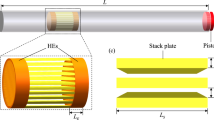Abstract
Thermodynamic mechanism of thermoacoustic self-excited oscillation is analyzed in this paper. The law of minimizing entropy flow is obtained basing on the fundamentals of finite-time thermodynamics. The results obtained here show that the thermoacoustic self-excited oscillation, which is a non-isentropic oscillation with power output corresponding to a limit cycle in the phase space takes place when hot temperature T h exceeds a threshold value T h *. The effect of nonlinear terms on the system will lead to the second harmonic wave.
Similar content being viewed by others
Bibliography
G. W. Swift, Thermoacoustic engines, J. Acoust. Soc. Am. 84, 1145 (1988).
P. H. Ceperley, Gain and efficiency of a traveling wave heat engine, J. Acoust.Soc. Am. 77, 1239 (1982).
S. Backhaus, G. W. Swift, A thermoacoustic stirling heat engine, Nature 399, 335 (1999).
T. Yazaki, A. Iwata, T. Mackawa, and A. Tominaga, Traveling wave thermoacoustic engine in a looped tube, Phys. Rev. Lett. 81, 3128 (1998).
X. Deng, Thermoacoustic essence of regenerator and the designing of thermoacoustic heat engine, Ph. D. Thesis, Huazhong University of Science and Technology, Chinese Wuhan, 1994.
P. S. Spoor and G. W. Swift, Thermoacoustic Separation of a He-Ar Mixture, Phys. Rev. Lett. 85, 1646 (2000).
R. S. Reid and G. W. Swift, Experiments with a flow-through thermoacoustic refrigerator, J. Acoust. Soc. Am. 108, 2835 (2000).
R. A. Hiller and G. W. Swift, Condensation in a Steady-flow thermoacoustic refrigerator, LAUR-99-2692, Los Alamos.
G. W. Swift, Thermoacoustic natural gas liquefier, Proceedings of the DOE Natural Gas Conference, Houston TX, March 1997.
Lord Rayleigh, The theory of sound, Dover, New York, 1945.
N. Rott, Damped and thermally driven acoustic oscillations in wide and narrow tubes, Z. Angew. Math. Phys. 20, 230 (1969).
N. Rott, Thermally driven acoustic oscillations, Part II: Stability limit for helium, Z. Angew. Math. Phys. 24, 54 (1973).
A. Tominaga, Oscillation mode gas in a looped tube with a Branch, Cryogenic Engineering 36, 178 (2001) (in Japanese).
J. C. Wheatley, T. J. Hofler, G. W. Swift, and A. Migliori, Experiments with an intrinsically irreversible acoustic heat engine, Phys. Rev. Lett. 50, 499 (1983).
J. C. Wheatley, T. J. Hofler, G. W. Swift, and A. Migliori, Understanding some simple phenomena in thermoacoustics with application to acoustic heat engines, Am. J. Phys. 53, 147 (1985).
G. W. Swift, Thermoacoustic Engines and Refrigerators, Physics Today, July 1995, pp. 22-28.
T. J. Hofler, Thermoacoustic Refrigerator Design and Performance, Ph. D dissertation, Univ. of California, San Diego, 1986.
G. W. Swift, Analysis and Performance of a Large Thermoacoustic, Engine J. Acoustic Soc. Am. 92, 1551 (1992).
G. W. Swift and W. C. Ward, Simple Harmonic Analysis of Regenerators, J. of Thermophysics and Heat Transfer 10, 652 (1996).
L. I. Rozonoer, A. M. Tsirlin, Optimal control of thermodynamic systems, Automation and Remote Control 1, 2, 3 (1983).
A. Tominaga, Thermodynamic aspects of thermoacoustic theory, Cryogenics 35, 427 (1995).
J. Xiao, Thermocoustic theory for cyclic regenerator, Part I: Fundament, Cryogenics 32, 895 (1992).
A. Tominaga, Thermoacoustic spontaneous oscillation of fluid, xxx 36, 163 (in Japanese).
F. Wu, Study of Finite time thermodynamics on Stirling machine, Ph. D. Thesis, Chinese Naval Academy of Engineering, 1998 (in Chinese).
L. Chen, Finite time thermodynamic analysis of irreversible processes and cycles, Ph. D. Thesis, Chinese Naval Academy of Engineering, 1998 (in Chinese).
K. Dong, The network modeling of thermoacoustic system and its experimental investigation, Ph. D. Thesis, Huazhong University of Science and Technology, Chinese Wuhan, 2000.
F. Wu, P. Deng, X. Deng, Active network modeling for regenerator of regenerative cryocooler, SEE 2000, New York, Wallingford (U.K.), vol. 3, pp. 1217-1224.
Q. Li, W. Zhang, F. Guo, H-matrix description of the performance of regenerator, SEE 2000, New York, Wallingford (U.K.), vol. 3, pp. 1203-1207.
Author information
Authors and Affiliations
Rights and permissions
About this article
Cite this article
Li, Q., Wu, F., Guo, F. et al. Thermodynamic Analysis on Thermoacoustic Self-Excited Oscillation. Open Systems & Information Dynamics 10, 391–402 (2003). https://doi.org/10.1023/B:OPSY.0000009558.63129.24
Issue Date:
DOI: https://doi.org/10.1023/B:OPSY.0000009558.63129.24




